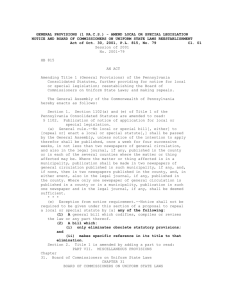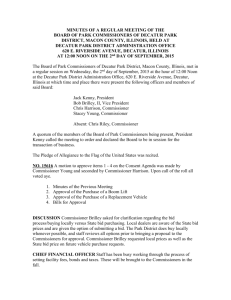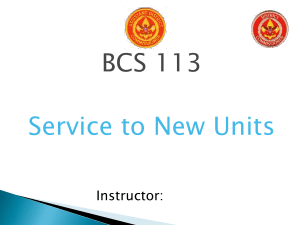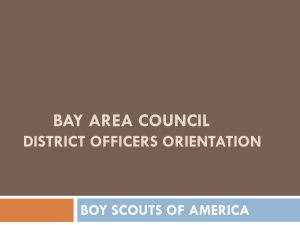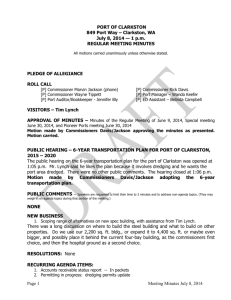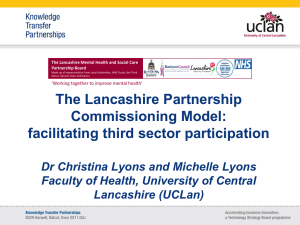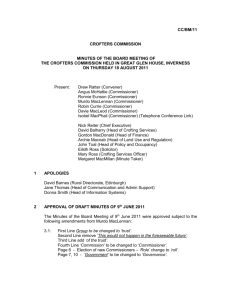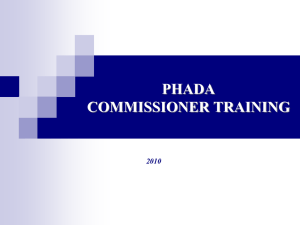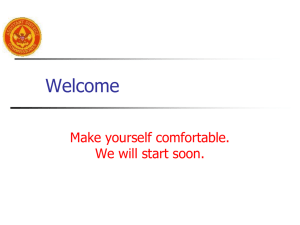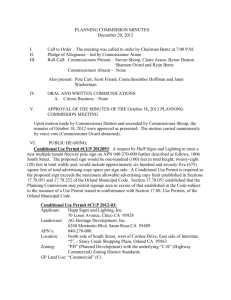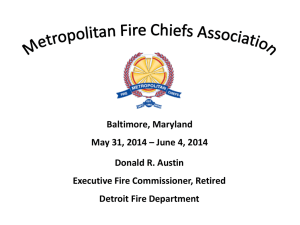Friendstorming and Recruiting New Commissioners
advertisement
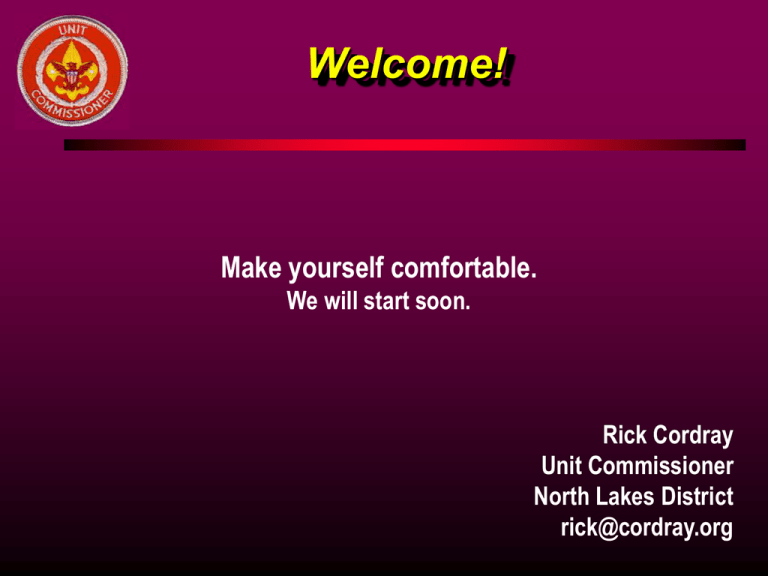
Welcome! Make yourself comfortable. We will start soon. Rick Cordray Unit Commissioner North Lakes District rick@cordray.org Unit Service l The whole hope of the movement rests upon two assumptions: l That unit leaders can use the movement's program in a manner to make a difference in the lives of young people. l That district volunteers will do whatever is necessary to ensure every unit leader's success. Finding Commissioners l They have to be people who can ‘jump the gap’ Jumping the Gap The role of a district volunteer requires different kind of commitment and motivation than being a parent l The rewards of being a district volunteer are different than those of a parent l Commitment and Motivation The Mission of the Boy Scouts of America is to prepare young people to make ethical and moral choices over their lifetimes by instilling in them the values of the Scout Oath and Law l Parents, to some degree or another, think this is worthwhile for their children l District volunteers must see it as worth their time and effort for the community l Rewards l The rewards of being a district volunteer are l Seeing progress toward achieving the mission of Scouting l Making and having fun with adult friends Commissioners l What makes a commissioner successful? (What makes a successful commissioner?) l Which points of the Scout Law are the most important? l What skills, experience, and/or talents are necessary? Necessary! New Commissioners l Are they going to have everything? l Knowledge l Experience l Manners l Contacts l Organization l ??? Formula for Commissioners? Very Effective! Not Very Effective Good At Something Great at Everything! Commissioner Reality Very Effective! Not Very Effective Good At Something Great at Everything! Commissioners l l The bad news is l Commissioners need oversight – the job is too important to leave to chance by just finding experienced people (if you can!) and trusting them The good news is l Great experience is not a predictor of commissioner success – new Scouters can be successful as commissioners Keys to Recruiting New Commissioners l Who’s a candidate – what do we look for? l Warm bodies? l Experience? l Existing relationship with units? l Looking for a place to show off their knots? My Thoughts l Recruit for retention l What makes people accept? l What makes people continue? l What makes people stay? Why Accept? Challenge l But not too scary l Responsibility l But a safety net l Reasonable time demands l Support – not going at it alone l Asked by a friend l Why Continue? Not oversold l Job is as advertised l Progress l Training happens, helps l Units improve l Find more friends l Why Stay At It? Rewarding l Unit service works l Expanding horizons l Can see the bigger picture l More efficient with more experience l District and unit friends l How to Recruit - Our Textbook Methods for Recruiting – Textbook Approach l l l l l l l l Determine what commissioner positions are needed. Determine the best prospects for the position. Research the prospects at the top of your list. Make an appointment. Make the sale. Ask for a commitment. Have a fall-back position in mind. Follow up. Designing for Exceptions l A l A Easy B C D E D E Not so easy (a.k.a. real world) B C What’s The Big Picture? l Target council goals are l Every unit has a unit commissioner l No more than 3 units served by a commissioner l Full commissioner staff – roundtable, ADCs l District committee has 20+ members in each district Do The Math 1050 units = 350 unit commissioners, maybe 70 ADCs l 12 districts = 90+ roundtable commissioners and staff l 12 districts = 240 district committee members l l = 700 district level volunteers? Compounding the Problem Many dedicated Scouting volunteers cheerfully tackle many jobs and do their best. l Too many jobs are given only partial attention. l How many volunteers wear too many hats? l How Do We Get There? “If every unit in the country would just recruit 2 new Scouts, membership would grow by….” l Remember ‘designing for exceptions’ l What’s Hardest? What’s the hardest part of recruiting for you? l How urgent is the need? l How important is the need? l Friendstorming (and Friendstorming on Tour) Grew out of need at the council level l Hardest problem, in my opinion, was identifying enough potential candidates to get beyond everyone’s 2-3 acquaintances l Friendstorming was intended to get past this roadblock l Developed in Chief Seattle Council in 20042005 l Friendstorming Promoted regionally in 2007-2009 l Rolled out nationally in 2010 l Now part of professional development training l It works l How Does It Fit In? l l l l l l l l l Determine what commissioner positions are needed. Friendstorming to develop prospect list Determine the best prospects for the position. Research the prospects at the top of your list. Make an appointment. Make the sale. Ask for a commitment. Have a fall-back position in mind. Follow up. My district and council volunteer philosophy: l We are here because l We believe in the promise of Scouting l We are having fun with friends Friendstorming Friendstorming – a tool to identify prospects l The purpose of Friendstorming is to expand the pool of prospects beyond our personal list l The Potential • Friendstorming can • • Kick off an effort to double or triple the number of people involved… • As commissioners, committee members, trainers, roundtable staff, and other district positions. Be part of a continuing recruiting program Friend-storming Friendstorming on Tour is the result of brainstorming about ways to find new friends. l Especially people who would fulfill the commissioner role. l Being a “friend to the unit”. l A typical Friendstorming on Tour meeting (at a district) turns up as many as 100 names. l These are potential new district volunteers. l Nuts and Bolts l l l Friendstorming On Tour is a series of meetings conducted at every district in the council. l But you can do just one locally. Those attending are asked to bring names to think about. l As many as possible. It’s possible to produce a list of 100+ names in one hour. The Tour Select two “tour guides” for each meeting. l A senior council volunteer and one executive. l Train & rehearse as necessary. l Promote the meeting to the district committee and commissioners. l Have the district leaders gather lists to help people remember names. l The Meeting Agenda Introduce the people leading the session. l Explain the purpose. l Tell a story… l Review the Rules l We only want names. l Please avoid saying no for a prospect. l Please don’t worry about which position might be filled by the names you offer l Agenda continued…. Begin the “Friendstorming” l Stick to the schedule l Close with “The Pledge” l Next Steps Get the list typed up. l The “tour guides” send out a thank you letter to the district Key 3. l The district Key 3 proceeds with recruiting. l Making It Work The district Key 3 are tasked with follow up and recruiting some of the prospects. l Other district volunteers may participate, but the Key 3 are primarily responsible. l Nominating committee? l Completing the Task l l l l l l l Determine what commissioner positions are needed. Friendstorming to develop prospect list Determine the best prospects for the position. Research the prospects at the top of your list. Make an appointment. Make the sale. Ask for a commitment. Have a fall-back position in mind. Follow up. Making the New Commissioner Successful Get them some training l Get them some resources l Set reasonable expectations l Respect their experience (close to zero?) l Encourage l Making It Really Work Make recruiting a priority. l It takes a lot of people with hands-on support to make unit service work l Friendstorming is an ongoing process. l Train everyone to keep their eyes open l Think ahead l
